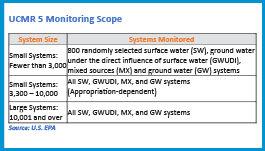PFAS, lithium among contaminants targeted in expanded utility monitoring
July 13, 2022

AWWA Articles
PFAS, lithium among contaminants targeted in expanded utility monitoring
All sizes of U.S. water utilities are ramping up for monitoring activities required in the Fifth Unregulated Contaminant Monitoring Rule (UCMR 5) that was finalized by the U.S. Environmental Protection Agency (EPA) in December 2021.
 UCMR is a recurring national water quality monitoring program required by the Safe Drinking Water Act (SDWA). It requires EPA to identify up to 30 unregulated contaminants for inclusion in the monitoring program to help provide information for future regulatory decisions on drinking water standards.
UCMR is a recurring national water quality monitoring program required by the Safe Drinking Water Act (SDWA). It requires EPA to identify up to 30 unregulated contaminants for inclusion in the monitoring program to help provide information for future regulatory decisions on drinking water standards.
The UCMR 5 monitoring activities will be implemented from Jan. 1, 2023, through Dec. 31, 2025, and could potentially include twice the number of U.S. water systems than required in previous UCMR rules.
“As with previous UCMRs, all systems serving more than 10,000 people will participate, and UCMR 5 will add 800 systems serving fewer than 3,300 people,” said Chris Moody, regulatory technical manager with the American Water Works Association’s (AWWA) government affairs office.
 “A notable change with UCMR 5 is that all systems serving between 3,300 and 10,000 people are expected to be required to participate,” Moody added. “Although the final number is dependent on how much funding EPA receives from Congress, EPA anticipates that enough funding will be available for all of these systems, bringing the total number of systems participating in UCMR 5 to more than 10,000.”
“A notable change with UCMR 5 is that all systems serving between 3,300 and 10,000 people are expected to be required to participate,” Moody added. “Although the final number is dependent on how much funding EPA receives from Congress, EPA anticipates that enough funding will be available for all of these systems, bringing the total number of systems participating in UCMR 5 to more than 10,000.”
EPA has already notified the largest systems and a portion of the small systems required to participate. The agency will notify small systems six months in advance of the respective year in which they will be monitored.
Samples will be collected and analyzed for a total of 29 per- and polyfluoroalkyl substances (PFAS) and lithium. Water systems will also need to provide information about facilities, including information about previous PFAS and lithium testing and treatment in addition to identifying potential current/historical sources of PFAS affecting each facility’s water supply.
Moody suggested that water systems prepare for UCMR monitoring by:
- Verifying receipt of an email or mailed letter notifying them of their participation in UCMR 5
- Setting up an account with the Safe Drinking Water Accession and Review System (SDWARS)
- Completing pre-monitoring activities by Dec. 31, 2022
- Reviewing EPA’s draft sampling schedule for each system
- If applicable, submitting plans for a groundwater representative monitoring plan at least six months in advance of the first scheduled sampling
- If a large system, contracting with an EPA-approved laboratory for analytical services
AWWA also recommends that water systems be prepared to have challenging conversations with their communities about PFAS testing, results and health effects of PFAS. Resources to support these efforts include AWWA’s Trending in an Instant, the Drinktap.org website, and other information available on AWWA’s PFAS resource page.
Advertisement